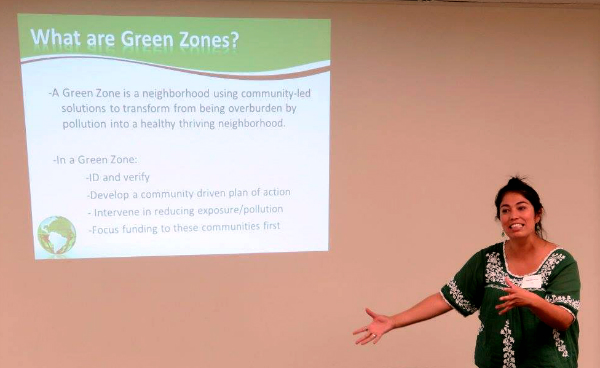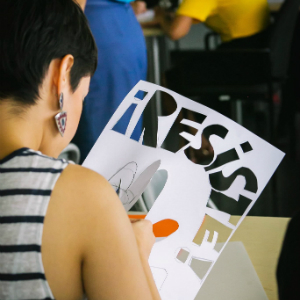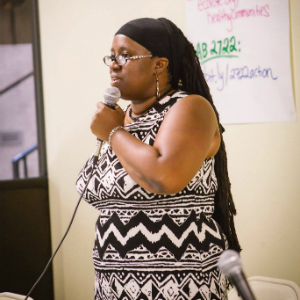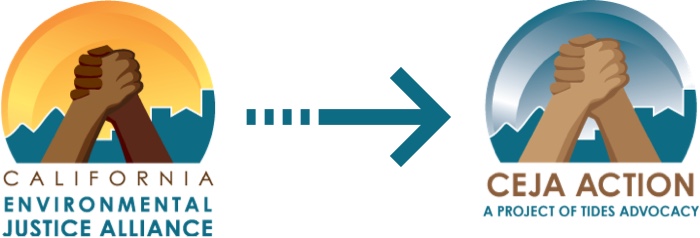2016 Statewide Green Zones Convening Highlights
On July 28th, CEJA hosted a Statewide Green Zones Convening that brought together over 120 community leaders from almost 50 organizations to cross-train and develop strategies for creating Green Zones across the state and build support for our Green Zones bills AB 2722 and SB 1000. It was an incredible day of workshops, panels and strategy sessions to explore the intersections between Green Zones and Just Transition, share ideas for strengthening and expanding Green Zones across the state, and continue building the statewide movement for #HealthyHoods. From our opening panel to our closing multi-cultural performance, we felt the power of Green Zones in California!
Our opening panel focused on the overlaps between Green Zones and the Just Transition framework, which are both premised on the need for comprehensive, community-led solutions that address the fundamental issues impacting our neighborhoods, economy, and environment.
By looking more closely at the intersection of these frameworks, we can see how they are deeply aligned in both values and action. Increasingly, the Just Transition frame is used to describe a transition away from the extractive fossil fuel economy and toward a more local, living, and climate-resilient economy that our communities need.
In fighting the bad and building the new, the Just Transition framework provides guiding principles for building a shared vision for a community. The example of the Clean Up Green Up campaign, which we celebrated during the convening, offers us important lessons in decades of coalition work that led to the first city ordinance of its kind to bring environmental and economic benefits to the communities of Boyle Heights, Pacoima, and Wilmington in Los Angeles.
The panel also highlighted emerging Green Zones in National City and Barrio Logan that are paving the way to address discriminatory land use practices that create the unhealthy mix of polluting industries with residential homes and schools. The Green Industrial Auto Park and Paradise Creek Affordable Housing projects are examples of how local residents are creating a local, thriving economy that will retain jobs in the community while keeping polluters out. That’s why we’re advancing SB 1000, a bill that will help advance equitable land use policy!
Together, Green Zones and Just Transition go hand-in-hand in building power for our communities to win the victories that will keep our families safe and healthy so they can thrive in vibrant, local economies based on shared prosperity and collective governance.
Watch the full video of the “Creating a Just Transition in Healthy Neighborhoods” panel here.
We were thrilled to have exciting breakout sessions that addressed the issues of gentrification, equitable development, cooperative economies, transportation justice, and securing investments for Green Zones. Participants and facilitators asked the real questions that are directly impacting our neighborhoods on the ground: How do we increase public and private investments to build community-led solutions while ensuring we don’t push out long-time residents? What are local, living economic models that advance environmental and climate goals while building the skills, capacity, and economic opportunities of residents? How can we link environmental justice and economic justice movements to bring good local jobs and equitable development into our neighborhoods? We also had a series of hands-on afternoon strategy sessions such as art and poster making as cultural resistance.
We were honored to have Jacqui Patterson, Director of Climate and Environmental Justice at the NAACP as our keynote speaker. It was inspiring to listen to her anecdotes from community groups around the country that are advancing equity by working towards more regenerative, interdependent, and cooperative systems that uplift rights for all people and protect the environment.
Jacqui helped us to see how these different examples are interconnected since the systems of oppression that are driving state violence are also at the root of environmental injustices.
Watch the full video of our keynote by Jacqui Patterson of NAACP here.

Our afternoon panelists discussed strategies to take our Green Zones work to the next level through intergenerational organizing and educating elected officials to build grassroots support for campaigns that can stop the over-concentration of pollution sources in Green Zones.
From the Inland Valley, to South Los Angeles, to unincorporated communities in the San Joaquin Valley, advancing Green Zones requires relationship building with multiple stakeholders and decision makers to support each other and amplify our voices.
Watch the full video of the “Taking Green Zones to the Next Level” panel here.
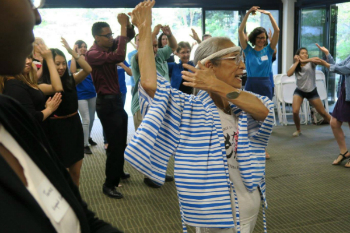 We closed out the day with an interactive and multi-cultural performance by Fandango Obon that got everyone on their feet and ready to take visionary and transformative actions for Green Zones.ur communities face similar struggles that bring us together to fight for state policies that will benefit all Green Zones. We were glad to learn that many allies in attendance left with plans to start Green Zones in their own cities as well.
We closed out the day with an interactive and multi-cultural performance by Fandango Obon that got everyone on their feet and ready to take visionary and transformative actions for Green Zones.ur communities face similar struggles that bring us together to fight for state policies that will benefit all Green Zones. We were glad to learn that many allies in attendance left with plans to start Green Zones in their own cities as well.
As we advance new state policies like AB 2722, the Transformative Climate Communities program that will fund Green Zones projects, we know momentum is only building to see even more community-led solutions become reality in our neighborhoods!
Check out more photos from our Statewide Green Zones Convening here.

